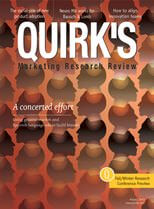Quirk’s August 2014
By Briana Brownell
Let’s compare plastic and reusable grocery bags. There are several differences, but one is this: your choice of bag says something about you. Although you might prefer getting them at the store over carrying your own, reusable bags communicate, “I’m eco-friendly! I care about the earth! I recycle!” In other words, when it comes to determining which type of bag people will carry—and really, most consumer behavior in general—social factors are important to consider. For example, some would even argue that we cannot completely trust survey results reflecting self-reported socially desirable behaviors.
Consumer behavior about new products or product categories are often hard to anticipate for many reasons, but one that is often overlooked is social factors. According to author Briana Brownell, the success of some new products heavily depends on social factors which are often undetectable during concept-testing. Failure to recognize these factors may blindside companies, causing unnecessary overspending on advertising or inventory.
However, not all products are equally influenced by social effects. So, as market researchers, how do we know when these factors do play an important role? Brownell says that, “the qualities of the product being launched determine which social elements may be relevant to integrate into a research program.” Here are four important guidelines:
- Is seeing someone else use or recommend the product the key to adoption? Awareness and word of mouth are most important for certain kinds of products. In her article, Brownell explains which types are most likely to fall under this category.
- Does adoption depend on the number of users? For example, social networks will only catch on if people sense that there will be widespread adoption. If no one is using Facebook, what is the point of joining?
- Is adoption socially acceptable? If not, perceptions must be changed before the product is adopted. Often, adoption by change agents and opinion leaders gives the right signal to the masses.
- Do product reviews aid adoption decisions? People often use others as shortcuts in their purchase decisions. Brownell discusses when peer or expert opinions are sought.
Social factors are always important to consider, yet when it comes to new product research, the stakes of ignoring them are even higher. To minimize the risk of overly-rosy market research, researchers should work to uncover which specific social factors play into the situation at hand and address them during the research process—or at least consider them when interpreting and reporting key findings. For more of Brownell’s tips, read her article here: http://bit.ly/1v0V6me.
This article was written by Research Rockstar intern Sarah Stites. Sarah is a student at Grove City College, and is a member of the Research Rockstar Scholarship program for college students.









